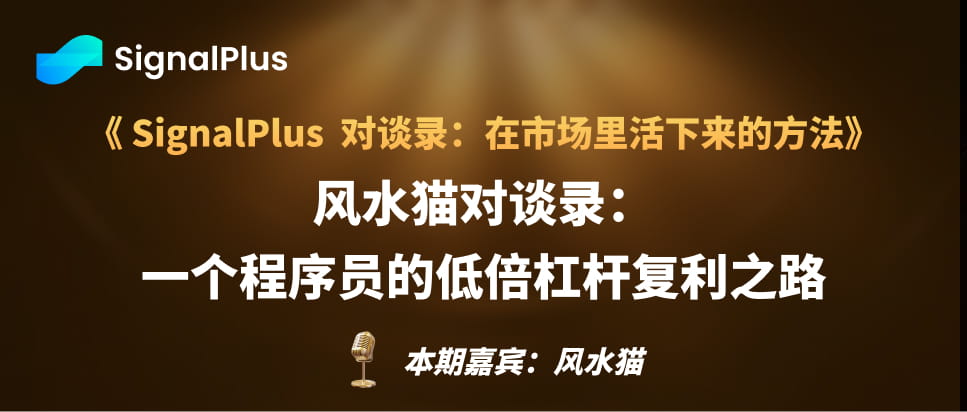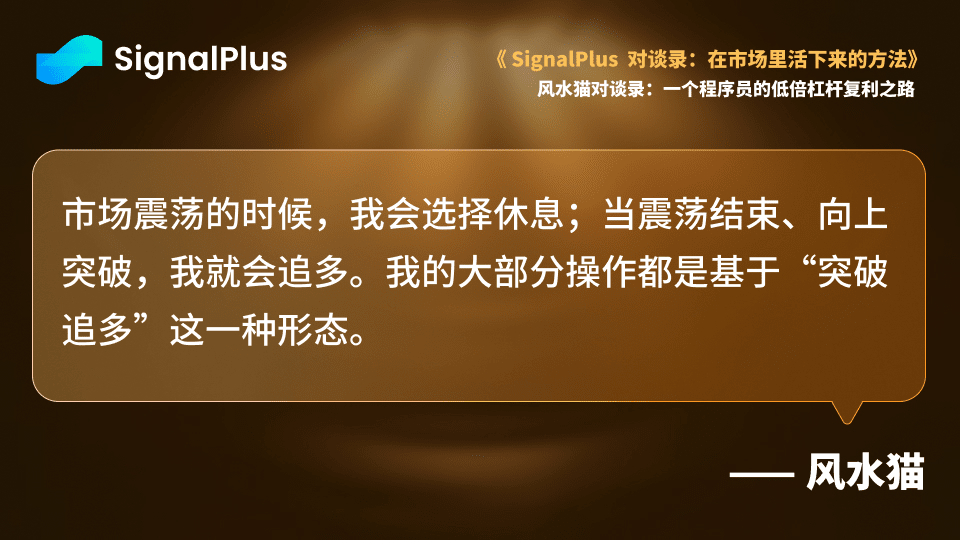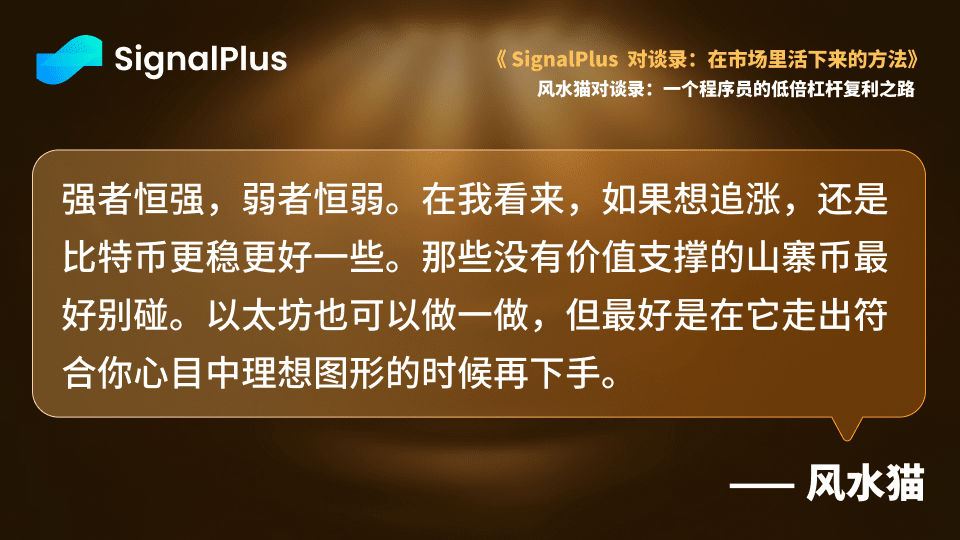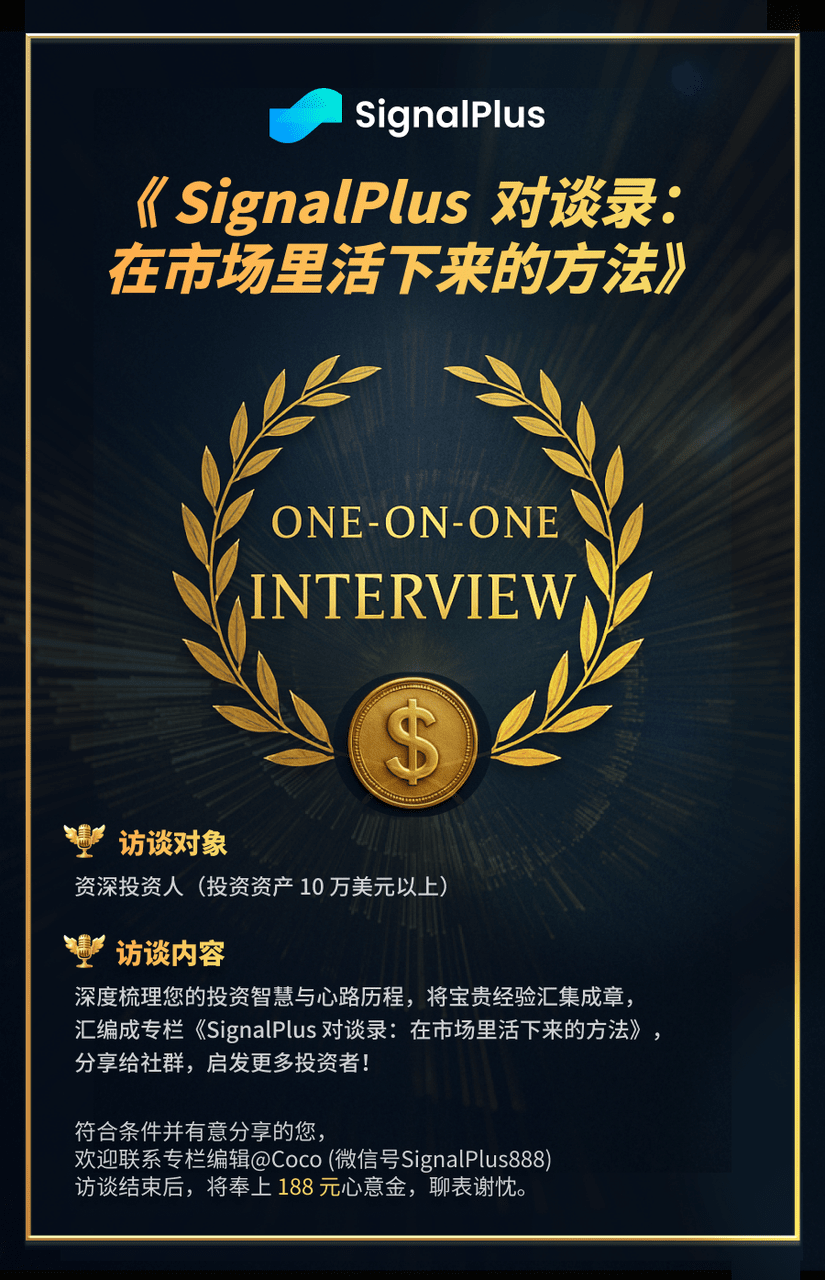
In Crypto, this fast-moving vanity fair, we are surrounded by all sorts of incredible success myths:
Some people rely on peeling the banker's car Meme coins to achieve 100x or 1000x achievements, while others imply that they have unique news channels and can ambush the exchange in advance; others are confident that the graphics they draw casually will become the market trend.
We chase ups and downs in the noise of KOLs, and exhaust our minds in endless charts and information flow. We try to become smarter, faster, and more omnipotent, but ultimately find that we are getting farther and farther away from stable profitability in frequent operations and endless anxiety.
But what if, the real answer is just the opposite? If the road to the market's holy grail is not more complex, but simpler? If the key to overcoming greed and fear is not a stronger ability to analyze, but a more 'clumsy' discipline?
This issue of (SignalPlus Big Shot Interview Record)'s guest, 'Fortune Cat', is such a 'clumsy' wise man. He gave up 99% of the market noise and the temptation to get rich, and reduced his arsenal to only one move - a simple and almost boring 'breakout chasing' strategy.
If you have also been physically and mentally exhausted in frequent operations, and lost your way in chasing hotspots, perhaps Fortune Cat's story will provide you with a different perspective: in the battle of winning and losing in the market, the busy ones often become prey, and those who can hold their breath are the hunters.
'Going to zero' is the biggest risk: from altcoin spot to Bitcoin low-leverage contracts
SignalPlus: Please give a brief self-introduction, Fortune Cat.
Fortune Cat: My previous profession was a programmer. It wasn't until 2017 when a ransomware virus called WannaCry came out, requiring ransom payment in Bitcoin, that I first heard the word 'Bitcoin'. I first really came into contact with Bitcoin in 2018 or 2019. When I first saw it, I didn't know how to buy it. Later, I accidentally discovered that it had risen a lot, so I slowly started to get in touch with this field.
SignalPlus: When did you officially buy Bitcoin or other cryptocurrencies?
Fortune Cat: I remember I bought coins as soon as I got my salary after work. At that time, the price of Bitcoin was about $8,000.
SignalPlus: Have you always been dollar-cost averaging into Bitcoin every time you get paid?
Fortune Cat: No. At the beginning, I mainly bought spot goods of altcoins, until one day there was a big crash and I lost all the money I had earned before. After that, I changed my mind and stopped doing spot (altcoins).
SignalPlus: After that crash, did you start to shift your trading to low-leverage contracts?
Fortune Cat: Yes. At that time, because I was new to futures contracts and didn't understand them very well, I crazily joined various communication groups and followed many industry KOLs. At that time, I came into contact with someone who recommended some real-time trading software to me. I found that there were many real-time traders on it. I observed their operations and followed their operations to invest.
SignalPlus: Can you talk about which traders have had the greatest impact on you? What are their respective styles?
Fortune Cat: The most impressive ones are Ma Deshui and Sunny Day. I found that they both use low leverage to trade contracts, and the core is to track the trend. I think their operating philosophy is correct, because you can't go against the market trend, you must grasp the market trend. But if you want to catch the trend, you can't use particularly high leverage, because too high leverage will be directly knocked out. I imitated their style and adopted a low-leverage contract method to pursue compound interest.
SignalPlus: Most people start with high-leverage contracts, lose everything after liquidation, and then retreat to do spot trading; why would you switch from spot trading to seemingly riskier low-leverage contracts?
Fortune Cat: At that time, a few coins impressed me deeply. The first was FIL (Filecoin), and the second was ICP (Internet Computer). These two projects rose many times during their peak, but after the crash, they never recovered. These experiences made me realize that many altcoins, if they don't have new narratives and funding, will really go to zero after they fall. Instead of holding altcoins without risk control, it's better to set a stop loss and use low leverage to trade contracts, and only trade mainstream coins like Bitcoin or Ethereum. This is a relatively correct and safe choice.
SignalPlus: So your transition can be more accurately described as: from 'altcoin spot' to 'low-leverage contracts for Bitcoin and Ethereum'?
Fortune Cat: Yes, you can say that.
Minimalist Trading System: Trend is king, only do 'breakouts after consolidation'.
SignalPlus: After these years of market experience, have you formed your own core investment philosophy or principles? What do you value most in different market environments?
Fortune Cat: What I value most is the market trend. Especially after the epidemic, I found that Bitcoin is following the trend of US stocks - if US stocks rise, it also rises. This observation has formed my core strategy: when the market fluctuates, I will choose to rest; when the shock ends and breaks upward, I will chase the rise. Most of my operations are based on this form of 'breakout chasing'.

SignalPlus: The market often has long periods of fluctuation, which is a great test of people's patience. How do you get through this stage? If you encounter a large drawdown, how do you adjust your mentality?
Fortune Cat: The maximum drawdown I can tolerate is 20%. Once this threshold is reached, I will definitely stop trading and rest. Similarly, I will also rest when the market is fluctuating without a trend.
Most of the time, the market does not conform to the ideal form in my mind. I only do one form: breakout after consolidation.
SignalPlus: What do you usually do when you're not trading?
Fortune Cat: I also have my own job. When I'm not trading, I spend most of my time at work, or occasionally playing games.
SignalPlus: Can you share a most memorable 'breakout chasing' trade? What was the situation at that time?
Fortune Cat: It was probably in early 2023. Bitcoin had been in a long bear market, but one night the price of Bitcoin broke through from 20,000 to 30,000. I felt that Bitcoin was about to restart its bull market, so I decisively went long and held until it reached over 50,000.
SignalPlus: What factors did you mainly base your judgment that Bitcoin was about to start at that time?
Fortune Cat: The first is the technical form of the chart. I remember that after the FTX explosion, it was silent for a while, and suddenly a K-line rose in volume.
Second, I think the price of 30,000 is not too high, and Bitcoin is still in the bottom area.
Also, most people will say that if you buy altcoins, you may never be able to get up again in your life; if you buy big pie (Bitcoin), it may return to that price.
SignalPlus: Have you considered allocating some altcoins that may rebound more violently?
Fortune Cat: Since the LUNA incident, I basically don't look favorably on altcoins. I occasionally play with a very small position, but the things that really make me money are never altcoins.
Including the later inscription, Meme coin, and Metaverse craze, their final endings are almost the same, so I will not invest a lot of money to chase these hotspots.
SignalPlus: So your idea is: No matter what market hotspot appears, you insist on only focusing on Bitcoin, right?
Fortune Cat: Basically, yes.
Risk control iron law: Three times leverage, full position compounding and 20% stop loss
SignalPlus: In your system, how many times is considered low leverage? How do you define this standard of 'low'?
Fortune Cat: Within three times leverage.
SignalPlus: How much position do you usually put in a trade?
Fortune Cat: Basically full position. Because my goal is compound interest, so low leverage is combined with full position operation.
SignalPlus: Full position with three times leverage, how do you set your stop loss?
Fortune Cat: The hard stop-loss line I set for myself is a loss of 20%. But in general, for example, if the market rushes high and fails to break through and then pulls back to the middle rail of the Bollinger Band, I will stop the loss and leave in advance.
SignalPlus: It's full position again, and tolerate 20% drawdown, the asset fluctuation will be relatively large, right? Will this test the mentality very much?
Fortune Cat: It really tests the mentality very much. I once made five times, then came back the same way, and then continued to make five times.
Withdrawal is very important. If you think a wave of market is good and you have made money, you must withdraw, and you must rest after withdrawal.
SignalPlus: It may be difficult for normal people to accept earning five times and then losing it back. How did you adjust your mentality at that time?
Fortune Cat: I was also very uncomfortable at the time, but there was no way. I could only subtly cheer myself up in my mind, saying that since you can do five times, it proves that this idea is correct. Since the principal has not lost much, then continue to execute according to this proven logic.
SignalPlus: The most difficult thing in trading may not be understanding the market, but sticking to your trading discipline. What advice do you have for novices who want to establish their own trading system?
Fortune Cat: First of all, you have to use small capital to try out what kind of style suits you. For me, because I have a lot of things to do usually and can't keep an eye on the market, I am more suitable for low-leverage long-term contracts. But some people are day traders with high leverage, and they may have multiplied many times in a few days.
SignalPlus: Many traders choose to resign from their jobs and devote themselves to trading after making money in the currency circle. Why didn't you do this and can always stick to the low-leverage style?
Fortune Cat: I sometimes can't control myself, at this time, I can turn on the exchange's 'contract cooling-off period' function.
In addition, because I am a programmer, I wrote myself a set of trading tools. I connected to the exchange's API interface and fixed the leverage at three times. I don't place orders on the exchange's App, but send instructions to the robot in WeChat, and trigger the server through Webhook to execute the transaction.
This will be relatively calm, and you will not frequently open the exchange software to operate.
SignalPlus: In other words, you use your customized trading interface to prevent being swayed by market sentiment?
Fortune Cat: Yes.
SignalPlus: When did you start using this method? Did you want to do this from the beginning, or did you do it after suffering losses?
Fortune Cat: After suffering some losses. I found that after losing money, I always couldn't help but want to fight back, and my emotions were very wrong. So I set a contract cooling-off period and developed this tool to force myself to stay calm and disciplined.
SignalPlus: When did your mentality reach a relatively peaceful and stable state?
Fortune Cat: It was after the experience of earning five times and then falling back, and then earning it back again. I found that as long as I continue to execute normally according to this logic, I will not suffer a big loss. Since my logic is not wrong, I will continue to firmly execute it.
SignalPlus: What other tools do you usually use to assist trading, such as TradingView?
Fortune Cat: In fact, TradingView and the charting tools that come with the exchange are similar. I usually just look at the naked K-line trend and draw trend lines myself for analysis. Although I have made some simple tools, I have not written particularly complex automated trading logic.
I once studied quantitative trading and also tried open-source frameworks like Freqtrade and API libraries like CCXT, but I found that building a truly effective strategy is very complex and time-consuming. I think my subjective trading effect is okay, so I gave up in-depth research.
'Bitcoin is too expensive' is the most dangerous cognitive trap for newbies.
SignalPlus: What do you think of the current market stage? Can you share your current trading ideas?
Fortune Cat: I went long when the price of Bitcoin was about $108,000. At that time, the market fluctuated between $100,000 and $110,000 for a long time, and many people (such as Liang Xi) began to be bearish. But I observed that the market had signs of breaking upward after the shock, so I chased in with a stop loss.
Now I am still bullish, but I will not guess where it can rise to, but will use a moving stop loss to follow the trend.
I will also refer to some of the real-time traders I follow to see when they close their positions, as a reference.
SignalPlus: Someone complained before that when Bitcoin was at 60,000, Ethereum was at 3,000, and when Bitcoin was at 100,000, Ethereum was still at 3,000, and now at 120,000, Ethereum is still at 3,000. From your trading experience, what are the differences between BTC and ETH?
Fortune Cat: I think the strong will always be strong, and the weak will always be weak. In my opinion, if you want to chase the rise, Bitcoin is more stable and better. It is best not to touch those altcoins that have no value support. Ethereum can also be done, but it is best to start when it comes out of the ideal graph in your mind.

SignalPlus: Many novices think that the price of Bitcoin is too high, and it is not possible to make any money by doing Bitcoin with small funds. What do you think of this idea?
Fortune Cat: I think this idea is completely wrong. Many people like to buy those altcoins whose K-lines are at the bottom, hoping to turn many times, and feel that buying Bitcoin can only turn once at most.
But my philosophy is to achieve compound interest through low leverage. If your win rate is stable, the flywheel effect brought by compound interest is amazing. And buying those low-priced altcoins, the probability is that they will continue to weaken.
SignalPlus: But many people understand the principle that 'buying altcoins is like buying lottery tickets, and buying Bitcoin is steady and solid,' but they still can't resist the temptation. How do you resist this temptation?
Fortune Cat: Because when I first started playing spot, altcoins gave me a head-on blow, and then I gave up. Most of the altcoins that rub hotspots are here to collect money.
SignalPlus: Do you usually communicate with other traders?
Fortune Cat: I joined a lot of groups, but I mostly lurk and see how others analyze. I also follow a lot of KOLs on Twitter and Weibo to see their views. But most people's ideas may not be very advisable.
If some people have real-time trading records, I may refer to their views; if there are no public real-time records, I basically will not refer to them and just treat them as a joke.
SignalPlus: Do you feel anxious when you see young KOLs on social media claiming to earn millions of dollars a week?
Fortune Cat: At the beginning, yes. Later, I found that this group of people did not have any real-time trading at all, and their main purpose was to earn commissions, so I never believed them again, just treat them as a joke.
Don't rush to enter the market: Start with watching 'Ma Deshui's'
SignalPlus: What is the most important advice or reminder you have for those who are just entering the crypto market, especially those interested in contract trading?
Fortune Cat: If you want to trade contracts, you can take out 10,000 to 20,000 yuan to try. If you can turn these 20,000 yuan into 200,000 yuan, then it proves that you have the ability. If these 20,000 yuan can't be made, I suggest you give up.
SignalPlus: So you don't recommend everyone to do contract trading?
Fortune Cat: It's not that I don't recommend it, it depends on whether you have the ability. If you really have the ability, you can do it with a few thousand U. I've noticed that some people who are more skilled in technology usually start with a few thousand U. If you don't make it, then there must be something wrong with your trading system or yourself.
SignalPlus: What are some good ways for newcomers to learn trading?
Fortune Cat: I think it's still necessary to watch other people's real-time operations. Everyone can go and see some of the trading records of 'Ma Deshui' before. I think learning to trade must be based on real money and silver. To be honest, I don't have much time to read books myself. I basically learn by observing how others trade.
Observe more those experts who can stably profit and have very low drawdowns, see what common characteristics they have, and then create your own trading system based on these characteristics, and then it is not too late to start the actual combat.
After reading Fortune Cat's story, do you also feel the same? In your investment career, have you also formed a unique way of playing and mentality?
(SignalPlus Interview Record: The way to survive in the market) is looking for experienced investors like you.
If you are a seasoned player managing more than $100,000 in investment assets, we cordially invite you to participate in our one-on-one in-depth interviews. We are eager to understand your unique investment style and winning strategies, and are willing to invest professional resources to compile your valuable experience into in-depth articles to share with the entire community.
Your success deserves to be seen. We look forward to your contact!



